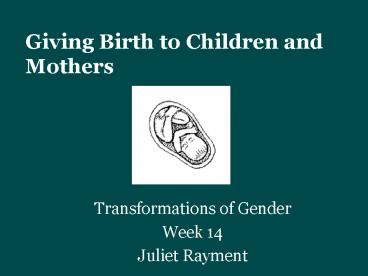Giving Birth to Children and Mothers - PowerPoint PPT Presentation
1 / 13
Title:
Giving Birth to Children and Mothers
Description:
Technology is seen as superior to nature. An attempt to control an unpredictable process ... I'm aware when I'm measuring a woman's fundus, I'm not free...I want it to ... – PowerPoint PPT presentation
Number of Views:128
Avg rating:3.0/5.0
Title: Giving Birth to Children and Mothers
1
Giving Birth to Children and Mothers
- Transformations of Gender
- Week 14
- Juliet Rayment
2
Birth-day
- Homebirth a debate!
- Womens experiences of birth
- Obstetricians and midwives
- Resistance and campaigns for change
- The futurewho knows?
3
The Homebirth Debate
Homebirth
Hospital birth
vs.
4
Womens experiencesAuthoritative Knowledge
- Technology is seen as superior to nature
- An attempt to control an unpredictable process
- e.g. Friedman Curve
5
Control and decision-making
- Control and autonomy are crucial to women having
a positive experience of birth even with
intervention (Fox and Worts) - In what ways might technology empower birthing
women?
6
Im aware when Im measuring a womans fundus,
Im not freeI want it to measure what its
supposed to measure on the chart erm, I dont
want to have to send her in because its a little
bit bigger or its a little bit small. I want to
protect her, I want to protect her from feeling
worried. I mean its ridiculous, I mean you can
know if a babys too big or too small, just by
looking at a woman when shes lying down and you
know how many weeks she is, you know if shes too
big or too small, usually, you know.
(Mia, midwife, interview 30.06.2005)
7
Obstetricians and midwivesNegotiating
professional boundaries
- Normal vs. abnormal
- All pregnancies now fall under medical
management and are normal only in retrospect. By
this logic, the midwife as practitioner in her
own right is defined out of existence. (Kirkham,
1986). - Providing woman-centred care within a high-tech
environment
8
Resistance and campaigning for change
- Stay or go?
- 2325 midwives left the profession between 1999
and 2000 - Ball et al. (2002) Why do midwives leave? and
- (2006) Why do midwives stay?
- Independent midwives
- Organised resistance can be politically
influential but at a personal cost - Subversion in the workplace an alternative to
public, organised campaigns.
9
- Im quite quiet about what I think, I dont tell
and lot of people because I dontits like this
midwife that I know shes been quite vocal in
what she believes in and what she thinks and its
like everybodys waiting for her to fail and when
they the midwife fail theyre just going to
clap their hands and be really pleased. - (Mabel, midwife, interviewed 13.07.05)
10
Campaigns for continuity of care
- Government rhetoric vs. reality
- Changing Childbirth 1993 the difficulties of
implementation - Independent Midwives Association Community
Midwifery Model - Association of Radical Midwives (ARM)
- Taking midwifery back to the roots
- Re-skilling midwives
- ukmidwifery yahoo group
- Association for Improvements in the Maternity
Services (AIMS) - Pressure group
- Offers advice to women
11
The Futurewho knows?
- The death of midwifery?
- The implementation of one-to-one midwifery care
across the country? - The embrace of technology as a welcome part of
normal birth? - The further development of the conveyor belt
birthing unit to cut costs? - The empowerment of all women in birthbut by what
means?
12
Links
- Association of Radical Midwives
- www.radmid.demon.co.uk
- Independent Midwives Association
- www.independentmidwives.org.uk
- Association for improvements in the Maternity
Services - www.aims.org.uk
13
References
- Ball, L., P. Curtis and M. Kirkham (2002). .Why
do Midwives Leave? Report of the Women.s
Informed Childbearing and Health Research Group.
London, Royal College of Midwives. Online.
Available at - www.rcm.org.uk/data/info_centre/layout_index.html.
- Cahill, H. A. (2001) 'Male appropriation and
medicalization of childbirth an historical
analysis', Journal of Advanced Nursing 33(3)
334-342. - Kirkham, M. (1986). A Feminist Perspective in
Midwifery. Feminist Practice in Womens Health
Care. C. Webb. Chichester, John Wiley and Sons
35-49. - Witz, A. (1992) Professions and Patriarchy,
London, Routledge. (See quote from British
Medical Journal 1873 354 on p.111)































